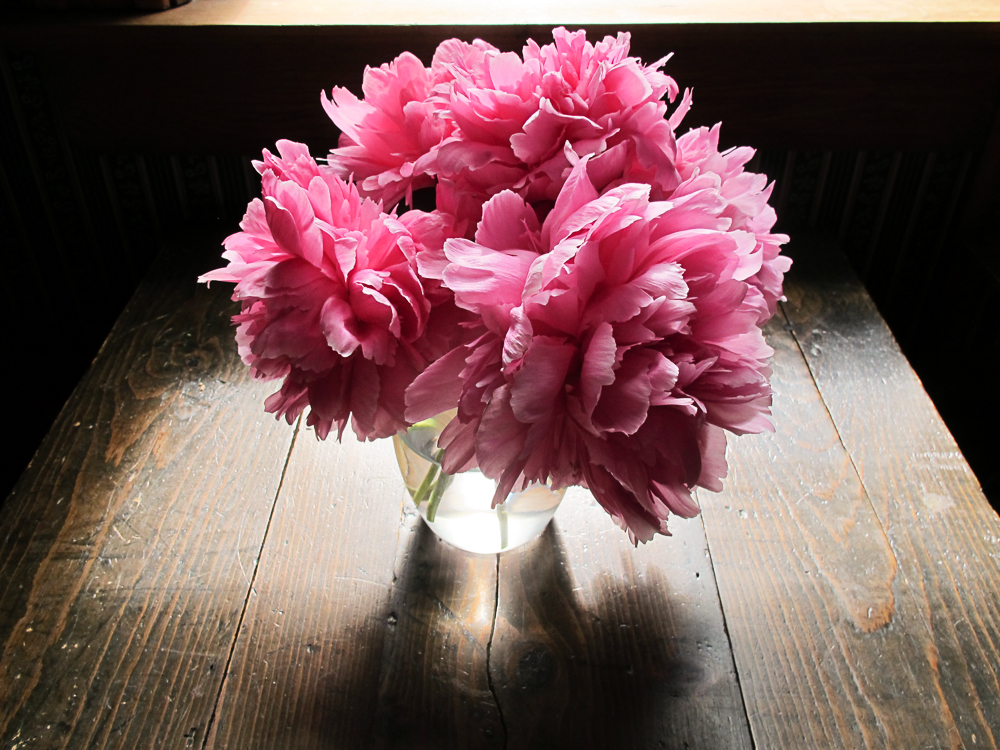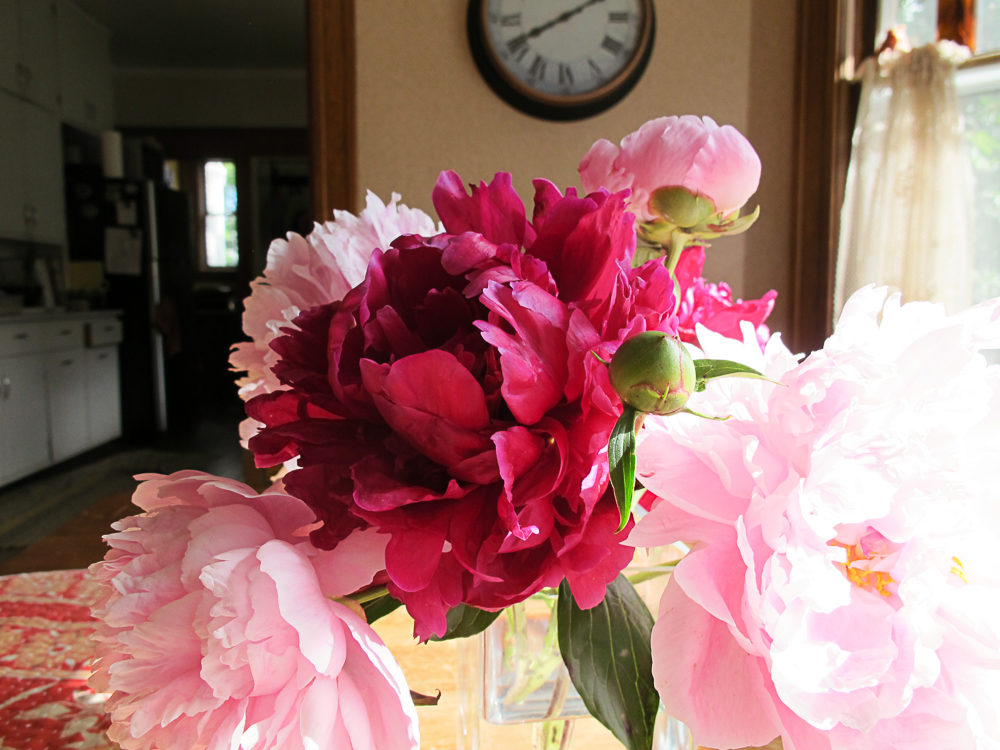Tips and tricks for growing them, displaying them and keeping them fresh for longer

I am madly in love with peonies, and will be until the day I die.
Our love affair really gets good in late May/early June, when the bushes in my backyard burst in pink glory, opening petal after petal after delicate, stunning promise of summer beauty. Wherever these beauties are destined to go, they are prepared with taffeta party dresses, fresh vibrant pinks and breathtaking radiance.
We flirt in the backyard for a while, then I clip some buds to take them home.
My husband knows. He thinks it’s cute, how I carry the big bouquets from room to room with me during the day, so I don’t have to spend a moment without the fluffy pink blooms in my peripheral vision.
This year, though, the peonies are so abundant and thoroughly dispersed throughout my home, I don’t have to carry them with me. Thanks to some extra stems from the farmers market to subsidize my backyard supply, there’s a bouquet on the dining room table; one by the tub; a big bunch next to my bed; another on the coffee table in the living room and a single bloom in the kitchen.

(There would be some in my office too, but it’s under renovation at the moment. My sweet husband has torn down the wallpaper with the ugly Roman columns border and is patching up the walls this week. It will soon be painted and ready to move in again…expect pictures in a few weeks!)
As I was declaring my undying love of peonies—and my over-the-moon bliss at this moment being peony season—a friend mentioned in passing that she didn’t love them. They’re pretty, she confessed, but so messy.
It was at that moment I thought maybe this friend, and my dear Rosy Blu readers, just need to get to know peonies the way I do. Perhaps this might stoke some sparks into a steady flame of early summertime love.
Tips for growing peonies
Don’t have a green thumb? Just skip to the next section, friend. There’s still plenty of peony love for you.
Much to my pleasant surprise, peonies are hard to kill. I bought three plants at the farmer’s market—which were barely more than stripped roots at the time—and plopped them in my backyard. I watered them semi-frequently, as often as my lazy gardener’s instincts allowed.
The first season I thought I bought duds. Nothing came up, and I wrote off my investment as a failure. (Turns out, I planted them past their peak spring growing season. “Not much of anything” was exactly what they were supposed to be doing that year.)
Since I assumed they were dead, my sweet peony plants were abused and neglected their first two seasons. Between the first two seasons, they were mowed over at least thrice, and sprayed as weeds twice more, after I forgot to communicate where they were planted, to multiple people.
But year three, early spring: there were sprouts. And then stems! and leaves! growing out of the ground. Miracle of miracles, a rightful bush was growing right where I once planted my pink peony roots. There were no blooms that season (I imagine my poor darlings felt like wounded war heros with head bandages and crutches at that point)…but every year since, there have been more and more big buds as if their childhood wasn’t traumatic at all.
We had a rough start, but my sweet peonies came through.
Here are my beginner’s tips for growing peonies:
- Peony plants are very forgiving of
terriblebeginner gardening skills. - They like a sunny spot in your yard, and some space around them to grow.
- In their first couple seasons, water generously. (After that, they will be fairly self-sustaining unless you’re having a very, very dry season.)
- Transplant in early spring or late fall. After transplant, don’t expect profuse blooms for a year or two—your plant needs time to get acquainted with her surroundings before showing off.
- After blooming season, enjoy the bushy leafy greenery for the summer.
- In fall, the leaves will dry up, turn brown and shrivel to the ground. I leave them there as insulation for the winter.
- In early spring you can go out and cut the past season’s growth away. Watch for new shoots and get excited for blooms in May/June, depending on your growing zone. (Here in Minnesota, it’s always right around June 1, and the season for one plant lasts about two weeks.)
Tips for cutting, displaying and improving the longevity of your peonies
If you cut your own peonies
From your own yard, or a generous gardening friend, this is the easiest (free!) way to get them, if you are so blessed.
- Heavy rains will strip a flowering bush of its pretty petals! If there’s a storm in the forecast, try to collect budding flowers before they are abused by wind and rain.
- Peonies are notorious for attracting lots of ants (and perhaps other insects you don’t want in your house). The ants don’t harm the plant or flowers, but are annoying. When this is a problem, I leave the blooms outside for 20 or 30 minutes after cutting (in water, of course) so the critters can migrate to greener pastures before the blooms are moved indoors.
- If you cut the bloom the day it opens outside (or just before), the flower will last longer on display in a vase. If it’s been open for a few days already, its petals are likely to fall off sooner.
Caring for cut peonies
No matter where you get them, use these tips for getting a longer life out of your blooms.
- Like most cut flowers, peonies will enjoy fresh water every day or two, and a bit of flower food. I use leftover flower food from the packets that come with purchased bouquets. If I’m out, I’ll use a DIY version of flower food—a drop of bleach to kill bacteria in the water, and a pinch of sugar to feed the flowers.
- If you have room, placing your bouquet in the fridge overnight will help the flowers last longer.
- As with other flowers, clip all the leaves that would otherwise be submerged under water in the vase. This keeps the water cleaner, and allows the stem to focus it’s nourishing energy on the blooms.
- If any of your cut buds haven’t opened, give them time and sunshine and they likely will burst open for you. I’ve seen it take up to a week or even a few days more—it depends on how developed they were when they were cut.
- After a few days, you might see shedding petals from some of the more tired blooms. I like to pull out the old flowers and make new, edited arrangements with the ones that are still fresh enough to enjoy.
- Knowing that the peonies like to shed petals, I sometimes plan ahead and display the vase on a pretty place mat, doily or scrap of fabric. It makes for easy cleanup when it’s time for the bouquet to retire.

Arranging your peonies
Alas, I have very little talent at arranging flowers. If you are like me, you might like the tips below. Peonies are kind to us in that way, because they look gorgeous all by themselves. If you are more skilled than me at arranging flowers, please share your tips in the comments—including what other flowers you’d pair with them in a vase, and how to make it look good! I’m all ears.
- Display just one stem in a wide-bottom bud vase, so the weight of the flower won’t topple the vase.
- Clip a bloom close to the flower (leaving an inch or so of stem) and display in a rose bowl vase. It’s a great way to showcase the intricate, delicate petals, and works great in locations you spend a lot of time but might not have tons of space—like your desk at work.
- Use a flower frog or criss-crossing tape to help distribute the stems if the top of your vase is wide and they all want to topple to the outsides.
- When in doubt, blue mason jars always pair beautifully with peony blooms.
- Try unconventional vases! My favorite is a teal elephant-shaped teapot whose spout is a trunk (which makes dumping stale water and adding fresh water VERY easy).